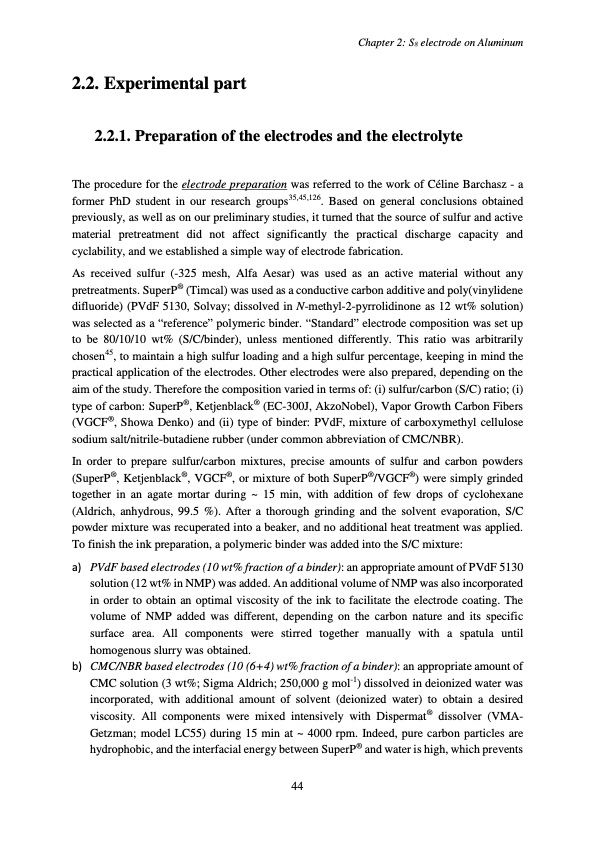
PDF Publication Title:
Text from PDF Page: 048
2.2. Experimental part 2.2.1. Preparation of the electrodes and the electrolyte The procedure for the electrode preparation was referred to the work of Céline Barchasz - a former PhD student in our research groups35,45,126. Based on general conclusions obtained previously, as well as on our preliminary studies, it turned that the source of sulfur and active material pretreatment did not affect significantly the practical discharge capacity and cyclability, and we established a simple way of electrode fabrication. As received sulfur (-325 mesh, Alfa Aesar) was used as an active material without any pretreatments. SuperP® (Timcal) was used as a conductive carbon additive and poly(vinylidene difluoride) (PVdF 5130, Solvay; dissolved in N-methyl-2-pyrrolidinone as 12 wt% solution) was selected as a “reference” polymeric binder. “Standard” electrode composition was set up to be 80/10/10 wt% (S/C/binder), unless mentioned differently. This ratio was arbitrarily chosen45, to maintain a high sulfur loading and a high sulfur percentage, keeping in mind the practical application of the electrodes. Other electrodes were also prepared, depending on the aim of the study. Therefore the composition varied in terms of: (i) sulfur/carbon (S/C) ratio; (i) type of carbon: SuperP®, Ketjenblack® (EC-300J, AkzoNobel), Vapor Growth Carbon Fibers (VGCF®, Showa Denko) and (ii) type of binder: PVdF, mixture of carboxymethyl cellulose sodium salt/nitrile-butadiene rubber (under common abbreviation of CMC/NBR). In order to prepare sulfur/carbon mixtures, precise amounts of sulfur and carbon powders (SuperP®, Ketjenblack®, VGCF®, or mixture of both SuperP®/VGCF®) were simply grinded together in an agate mortar during ~ 15 min, with addition of few drops of cyclohexane (Aldrich, anhydrous, 99.5 %). After a thorough grinding and the solvent evaporation, S/C powder mixture was recuperated into a beaker, and no additional heat treatment was applied. To finish the ink preparation, a polymeric binder was added into the S/C mixture: a) PVdF based electrodes (10 wt% fraction of a binder): an appropriate amount of PVdF 5130 solution (12 wt% in NMP) was added. An additional volume of NMP was also incorporated in order to obtain an optimal viscosity of the ink to facilitate the electrode coating. The volume of NMP added was different, depending on the carbon nature and its specific surface area. All components were stirred together manually with a spatula until homogenous slurry was obtained. b) CMC/NBR based electrodes (10 (6+4) wt% fraction of a binder): an appropriate amount of CMC solution (3 wt%; Sigma Aldrich; 250,000 g mol-1) dissolved in deionized water was incorporated, with additional amount of solvent (deionized water) to obtain a desired viscosity. All components were mixed intensively with Dispermat® dissolver (VMA- Getzman; model LC55) during 15 min at ~ 4000 rpm. Indeed, pure carbon particles are hydrophobic, and the interfacial energy between SuperP® and water is high, which prevents Chapter 2: S8 electrode on Aluminum 44PDF Image | Accumulateur Lithium Soufre

PDF Search Title:
Accumulateur Lithium SoufreOriginal File Name Searched:
WALUS_2015_archivage.pdfDIY PDF Search: Google It | Yahoo | Bing
Sulfur Deposition on Carbon Nanofibers using Supercritical CO2 Sulfur Deposition on Carbon Nanofibers using Supercritical CO2. Gamma sulfur also known as mother of pearl sulfur and nacreous sulfur... More Info
CO2 Organic Rankine Cycle Experimenter Platform The supercritical CO2 phase change system is both a heat pump and organic rankine cycle which can be used for those purposes and as a supercritical extractor for advanced subcritical and supercritical extraction technology. Uses include producing nanoparticles, precious metal CO2 extraction, lithium battery recycling, and other applications... More Info
| CONTACT TEL: 608-238-6001 Email: greg@infinityturbine.com | RSS | AMP |